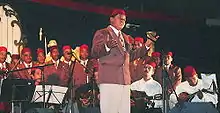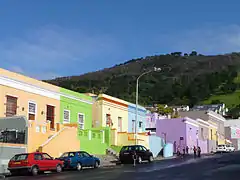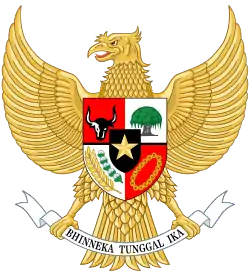Cape Malays
Cape Malays (Afrikaans: Kaapse Maleiers) are an ethnic group or community in South Africa. The name is derived from the Cape of Good Hope and the Malay race people originally from Indonesian/Malay archipelago, mostly from the Dutch East Indies colony (present-day Indonesia),[2] a Dutch colony for several centuries, and Dutch Malacca,[3] which the Dutch held from 1641 to 1824.[4] The community's earliest members were enslaved Javanese transported by the Dutch East India Company (VOC).[5] Key figures in the arrival of Islam were Muslim leaders who resisted the company's rule in Southeast Asia. Some, like Sheikh Yusuf, were exiled to South Africa by the company, which founded and used Cape Town as a resupply station for ships travelling between Europe and Asia. They were followed by slaves from various other Southeast Asian regions, and political dissidents and Muslim religious leaders who opposed the Dutch presence in what is now Indonesia. During the eighteenth century, Malay was the lingua franca of enslaved and free Muslims, though they came from East Africa, Madagascar, and India, as well as Indonesia. The use of the Malay language established the moniker "Malay" for all Muslims irrespective of their geographic origins.[6] By the 19th century, the term was used to describe anyone at the Cape who was a practicing Muslim, while Afrikaans had overtaken Malay as the group's lingua franca.
 Malay bride and bridesmaids in South Africa. | |
| Total population | |
|---|---|
| 200,000 | |
| Regions with significant populations | |
Western Cape, Gauteng | |
| Languages | |
| Afrikaans, Arabic Afrikaans, South African English Historically Malay, Dutch[1] | |
| Religion | |
| Sunni Islam | |
| Related ethnic groups | |
| Javanese, Malays, Indians, Africans, Malagasy, Cape Dutch, Dutch, Cape Coloureds, Bugis |
Terminology
The Cape Malay identity can be considered the product of a set of histories and communities as much as it is a definition of an ethnic group. Since many Cape Malay people have found their Muslim identity to be more salient than their "Malay" ancestry, people in one situation have been described as "Cape Malay", or "Malays" and in another as Cape Muslim by people both inside and outside of the community.[7] Also, over time, the original Indonesian slaves intermarried with various other groups, including other slaves from South[6] and Southeast Asia, Madagascar, and native African groups.
The "Cape Malay" identity was also a subcategory of the "Coloured" category, in the terms of the apartheid-era government's classifications of ethnicity.[8][9]
The term Malay may have originated from the Malayo-Portuguese language that was a lingua franca in many Asian ports.[6]
Culture

The founders of this community were the first to bring Islam to South Africa. The community's culture and traditions have also left an impact that is felt to this day. The Muslim community in Cape Town remains large and vibrant. It has expanded greatly beyond those exiles who started the first mosques in South Africa.[10][11]

People in the Cape Malay community predominantly speak Afrikaans, but frequently also English. They no longer speak Malay or other languages which their ancestors used, although various Malay words and phrases are still employed in daily usage.
Adaptations of traditional foods such as bredie, bobotie, sosaties and koeksisters are staples in many South African homes. Faldela Williams wrote three cookbooks, including The Cape Malay Cookbook, which became instrumental in preserving the cultural traditions of Cape Malay cuisine.[12][13]
This cultural group developed a characteristic 'Cape Malay' music. An interesting secular folk song type, of Dutch origin, is termed the nederlandslied. The language and musical style of this genre reflects the history of South African slavery; it is often described and perceived as 'sad' and 'emotional' in content and context. The nederlandslied shows the influence of the Arabesque (ornamented) style of singing. This style is unique in South Africa, Africa and probably in the world.
Cape Malay music has been of great interest to academics, historians, musicologists, writers and even politicians. The well-known annual Cape Town Minstrel or Carnival street festival is a deep-rooted Cape Malay cultural event; it incorporates the Cape Malay comic song or moppie (often also referred to as ghoema songs). The barrel-shaped drum, called the 'ghoema', is also closely associated with Cape Malay music.
Demographics

It is estimated that there are about 166,000 people in Cape Town who could be described as Cape Malay, and about 10,000 in Johannesburg. The picturesque Malay Quarter of Cape Town is found on Signal Hill, and is called the Bo-Kaap.
Many Cape Malay people also lived in District Six before they, among many other South African people of diverse ethnicity, were forcefully removed from their homes by the apartheid government and redistributed into townships on the Cape Flats.
International relationship
Connections between Malaysians and South Africans took up when South Africa rejoined the international community. The latter's re-entry was welcomed by the Malaysian government and many others in the Southeast Asian region. Non-governmental organisations, such as the Federation of Malaysia Writers' Associations, have since set on linking up with the diasporic Cape Malay community.[14] There is also an increase in the interest of the food, culture and heritage of Cape Malay descendants around the world.[15]
References
- Stell, Gerald (2007). "From Kitaab-Hollandsch to Kitaab-Afrikaans: The evolution of a non-white literary variety at the Cape (1856-1940)". Stellenbosch Papers in Linguistics (PDF). Stellenbosch University. 37. doi:10.5774/37-0-16.
- Vahed, Goolam (13 April 2016). "The Cape Malay:The Quest for 'Malay' Identity in Apartheid South Africa". South African History Online. Retrieved 29 November 2016.
- Winstedt, Sir Richard Olof (1951). "Ch. VI : The Dutch at Malacca". Malaya and Its History. London: Hutchinson University Library. p. 47.
- Wan Hashim Wan Teh (24 November 2009). "Melayu Minoriti dan Diaspora; Penghijrahan dan Jati Diri" [Malay Minorities and Diaspora; Migration and Self Identity] (in Malay). Malay Civilization Seminar 1. Archived from the original on 22 July 2011.
- Theal, George McCall (1894). South Africa. New York: G.P. Putman's Sons. p. 35. Retrieved 12 December 2009.
- "Indian slaves in South Africa". Archived from the original on 20 March 2008. Retrieved 24 November 2011.
- "Cape Malay | South African History Online". V1.sahistory.org.za. Archived from the original on 4 October 2011. Retrieved 12 May 2013.
- "Race Classification Board: An appalling 'science'". Heritage.thetimes.co.za. 2007. Archived from the original on 23 April 2012. Retrieved 12 May 2013.
- Leach, Graham (1987). South Africa: no easy path to peace. Methuen paperback. p. 73. ISBN 978-0-413-15330-2.
- tinashe (13 January 2012). "History of Muslims in South Africa: 1652 - 1699 by Ebrahim Mahomed Mahida". South African History Online. Retrieved 15 September 2017.
- "History of Muslims in South Africa". maraisburg.co.za. Retrieved 15 September 2017.
- Jackman, Rebecca (28 May 2014). "Cape Malay Cooking Guru Faldela Williams Dies at 62". Cape Times. Cape Town, South Africa. Retrieved 13 November 2016 – via HighBeam Research.
- Lewis, Esther (27 May 2014). "Faldela Williams lives on in cookbook". Johannesburg, South Africa: IOL. Archived from the original on 13 November 2016. Retrieved 13 November 2016.
- Haron, Muhammed (2005). "Gapena and the Cape Malays: Initiating Connections, Constructing Images" (PDF). SARI: Jurnal Alam Dan Tamadun Melayu. Universiti Kebangsaan Malaysia. 23: 47–66. Archived from the original (PDF) on 29 November 2016. Retrieved 28 November 2016.
- "Cape Malay Samosas with Mint-Cilantro Dipping Sauce". MeyerFoodBlog. Retrieved 2 March 2017.
External links
- Kramat An early religious leader's legacy remains on Robben Island.
- Official South African history site Early context for "Cape Malay" community.
- The Cape Malay Choir Board An umbrella organisation for Cape Malay singing ensembles.
- "Cape Malay" references A descriptive bibliographic paper examining the contested identity of "Cape Malay."
- Sparse website with some information about Cape Malay musical instruments and music.
- Cape Mazaar Society
| Wikimedia Commons has media related to Cape Malays. |
